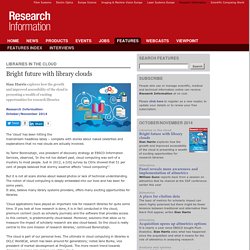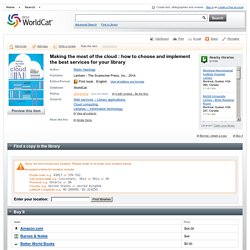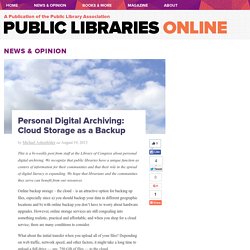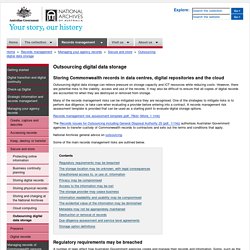

Cloud computing for libraries, public version. New York Public Library CTO Aboyoun on cloud, storage, future of the library. Jane Aboyoun, CTO of the New York Public Library, is in the middle of a cultural transformation of an institution that's increasingly thinking cloud first.

The New York Public Library (NYPL) has 92 locations throughout the Bronx, Staten Island and Manhattan, 12,000 devices and a staff of 85 IT professionals. Aboyoun sees a bright future for libraries, but one that'll be different than the previous role. The future library will be more of a community hub that'll connect its customers by and to technology. Here are a few key points from my talk with Aboyoun: Cloud Computing for Librarians and Digital Curators. Bright future with library clouds - Libraries in the cloud. Sian Harris explores how the growth and improved accessibility of the cloud is presenting a wealth of exciting opportunities for research libraries The ‘cloud’ has been hitting the mainstream headlines lately – complete with stories about naked celebrities and explanations that no real clouds are actually involved.

As Tamir Borensztajn, vice president of discovery strategy at EBSCO Information Services, observed, ‘In the not too distant past, cloud computing was sort-of a mystery to most people. Just in 2012, a [US] survey by Citrix showed that 51 per cent of people believed that stormy weather affects “cloud computing”.’ But it is not all scare stories about leaked photos or lack of technical understanding. The notion of cloud computing is deeply embedded into our lives and has been for some years.It also, believe many library systems providers, offers many exciting opportunities for libraries. Making the most of the cloud : how to choose and implement the best services for your library (Book, 2014)
The book is well set out and easy to read.

It is also comprehensive in coverage and easily understood by someone without extensive technical knowledge. It serves as a useful introduction to cloud computing for libraries and is recommended to librarians seeking to understand the role of cloud computing in their work and to evaluate the relevance of cloud computing services.
Australian Library Journal Written by the director of technology services at the Northeast Kansas Library System in Lawrence, Kansas, this book takes the reader through the most popular cloud services being used in libraries and breaks them down so that the user can know how to pick the best one for their particular library's needs. Application of cloud computing in Libraries carrot2. Cloud Computing a emergent technology Proquest. Moving the Wellcome Library to the cloud. Robert Kiley, Head of Digital Services at the Wellcome Library, explains why the Library is embarking on an exciting new project to prototype a cloud-based digital library platform.

If successful, the platform will be made available to other cultural heritage organisations to use. As the scale of the Library’s digitisation programme continues to grow – we have already digitised over 16m pages; a figure which will grow to over 30m by 2018 – we need to ensure that we can continue to deliver this content in an efficient and an effective way. Using cloud-computing services to deliver content is an obvious solution, and one increasingly adopted by organisations throughout the world. Beyond this simple requirement there is a much bigger ambition to position the Wellcome Library as a pioneer in the development of a new, interoperable, fully-scalable, digital library platform and, crucially, to make this platform available for other cultural heritage organisations to use.
Assessing the Impact of Cloud Computing and Web Collaboration on the Work of Distance Library Services EBSCO. A File Storage Service on a Cloud computing environment for digital libraries EBSCO. How Cloud Computing Works" Let's say you're an executive at a large corporation.

Your particular responsibilities include making sure that all of your employees have the right hardware and software they need to do their jobs. Buying computers for everyone isn't enough -- you also have to purchase software or software licenses to give employees the tools they require. Whenever you have a new hire, you have to buy more software or make sure your current software license allows another user. It's so stressful that you find it difficult to go to sleep on your huge pile of money every night. Soon, there may be an alternative for executives like you. In a cloud computing system, there's a significant workload shift. Ask.com - What's Your Question? Cloud Library. You can browse the shelves that your library set up by category or you can use the filter button to filter by genre.

Use the 3M Cloud Library PC Software to transfer e-books to your Nook Simple Touch and Kobo eReader . If you'd like to take notes while reading or bookmark your spot, simple click the small box at the top right hand side of the screen to open a spot to jot down your notes and create your own bookmark. The 3M Cloud Library automatically syncs to all your devices that have the 3M Cloud Library App downloaded to them. You can start reading on your iPad and continue later while waiting some where and reading from your phone - right where you've left off. Compatible devices: Oracle Storage Cloud Service Overview. Cloud computing and virtualization technologies in libraries / Sangeeta N. Dhamdhere, Modern College of Arts, Science and Commerce, India, [editor]. Cloud computing for libraries (The Tech Set series, #11), by Marshall Breeding EBSCO. Title.php?id=048477&category_code=# Cloud Computing for libraries Marshall Breeding. MagicScroll eBook Reader.
Personal Digital Archiving: Cloud Storage as a Backup. By Michael Ashenfelder on August 19, 2013 This is a bi-weekly post from staff at the Library of Congress about personal digital archiving.

We recognize that public libraries have a unique function as centers of information for their communities and that their role in the spread of digital literacy is expanding. We hope that librarians and the communities they serve can benefit from our resources. Online backup storage – the cloud – is an attractive option for backing up files, especially since a) you should backup your data in different geographic locations and b) with online backup you don’t have to worry about hardware upgrades.
However, online storage services are still congealing into something realistic, practical and affordable, and when you shop for a cloud service, there are many conditions to consider. What about the initial transfer when you upload all of your files? What if the connection gets dropped during the upload? Cloud-service costs and pricing plans vary wildly. IFLA winds of change paper cloud computing. New Project on Privacy and Cloud Computing in Public Libraries (and some aftermath) This week, at the Center for Information Policy Research, I launched a new project on Privacy and Cloud Computing in Public Libraries:

The Library Cloud Pros and Cons. As libraries’ cloud-computing options multiply, LJ looks at the pros and cons of jumping in By Edward M.

Corrado & Heather Lea Moulaison Cloud computing can be defined in a number of ways, making it confusing for librarians to understand what is available and what it delivers. Although computer scientists and technologists may have a strict definition of cloud computing involving “on-demand network access to a shared pool of configurable computing resources” (see the NIST Definition of Cloud Computing), for non-IT librarians it’s enough to think about cloud computing as library data and services hosted beyond the library’s walls and accessible via the web.
More and more electronic resources and software used in libraries are hosted in the cloud. Saint Paul Public Library. Outsourcing digital data storage. Storing Commonwealth records in data centres, digital repositories and the cloud Outsourcing digital data storage can relieve pressure on storage capacity and ICT resources while reducing costs.

However, there are potential risks to the viability, access and use of the records. It may also be difficult to ensure that all copies of digital records are accounted for when they are destroyed or removed from storage. Many of the records management risks can be mitigated once they are recognised. One of the strategies to mitigate risks is to perform due diligence; ie take care when evaluating a provider before entering into a contract. Records management risk assessment template (pdf, 76kb) (Word, 1.1mb) The Records Issues for Outsourcing including General Disposal Authority 25 (pdf, 111kb) authorises Australian Government agencies to transfer custody of Commonwealth records to contractors and sets out the terms and conditions that apply.
National Archives general advice on outsourcing. Professional Degree Programs. Handheld devices promise to dominate the future of software platforms as a result of the rapid convergence of computers and mobile phones. The number of mobile subscribers is continuously increasing, which makes Cloud and Mobile Computing an exciting and growing field. The Cloud and Mobile Computing Applications emphasis will help you master the analysis, evaluation and implementation of Cloud and Mobile Computing principles as well as the appreciation of mobile platform project development issues, including design, development, communication, management, information security and usability.
You will investigate the differences between desktop and mobile computing. You will dissect mobile apps and tool suites; learn about cutting-edge mobile software, frameworks, libraries and integrated environments. Webinar - Cloud Computing: Benefits and Barriers - 2012-10-11. Cloud Based Services for Your Library A LITA Guide eBook Library Central. Accountability and security in the cloud First Summer School, Cloud Accountability Project, A4Cloud, Malaga, Spain, June 2 6, 2014 revised selected papers and lectures TROVE.
From Kookaburra to the Cloud: where to now for copyright in Australia [linux.conf.au 2014] Google to Launch Government Cloud. Google will launch a government-specific version of its popular cloud computing offerings, the company said Tuesday, Sept. 15. The Google announcement came just hours after federal government officials unveiled Apps.gov, a Web-based storefront designed to let federal agencies easily acquire cloud computing applications. The Google government cloud will offer a version of the commercial Google Apps suite -- which includes hosted e-mail, word processing, collaboration and Web site creation services -- that's tailored to meet specific public-sector requirements.
The company plans to launch the new offering in 2010, and it will be available to federal, state and local government agencies. The Standards Question. Cloud computing involves the movement of content and applications from personal computers and private data centers to platforms floating somewhere in cyberspace. Users are tethered to their digital property only by an Internet connection; someone else provides and maintains the hardware and software supporting the services they use. Ideally, this shouldn’t give users anything to worry about. Reality, of course, is different. “We still have a long way to go to define what clouds can do and how users should interact with them,” says Vint Cerf, a father of the Internet who is now a vice president and chief Internet evangelist for Google.
The Beginner's Guide to the Cloud. "The cloud" is one of those trendy tech terms a lot of people use but can't clearly define. What is the cloud? When do you encounter it? How can it benefit your business? If you use any kind of social media or online data drive, you're already using the cloud; you just may not realize it. In this beginner's guide, we break down the who, what, where and why of one of tech's most abstract terms. How Big Is the Cloud? [INFOGRAPHIC] In the near future, when Wi-Fi becomes ubiquitous and we enjoy Internet access everywhere we go, it won't matter what kind of computer you own or how big your hard drive is.
All of your documents, music and pictures — all of you, basically — will store conveniently in the cloud. At least, that's what big names like Google, Amazon and Microsoft are betting on by ramping up their cloud-based storage and service capabilities. With massive remote server clusters, these companies can host ridiculously large storage for users. Where is the cloud? Geography, economics, environment, and jurisdiction in cloud computing. SungardASVoice: 7 Common Misconceptions About Security Threats In Cloud Computing. By Sue Poremba.
Future library resource discovery. Social Success - 10 Benefits of Cloud Computing - Salesforce UK. An Introduction. A brief history of cloud computing. One of the first questions asked with the introduction of a new technology is: “When was it invented?” Cloud through the ages: 1950s to present day. A history of cloud computing. Hybrid clouds to dominate the IT landscape in Australia. Recent analysis suggests hybrid cloud is two to five years off hitting the mainstream in Australia, but there is a flurry of activity as organisations gear up for it. Advantages and Disadvantages of Cloud Computing. Cloud computing. Cloud computing metaphor: For a user, the network elements representing the provider-rendered services are invisible, as if obscured by a cloud. What is Cloud Computing and How will it Affect Libraries? As with many questions about the future of technology, I’m afraid that the only completely honest answer to the questions in the title of this post is probably “I don’t know and neither does anyone else”.
So pardon me while I make a provisional attempt to answer this unanswerable question. If you’ve used any of the popular Web 2.0 services over the past few years (e.g. Gmail, Wikipedia, Flickr or Twitter), you already have some experience with cloud computing, since most of these applications are hosted in the large online data centers that are the hallmark of cloud computing. How It Works: Cloud Computing.